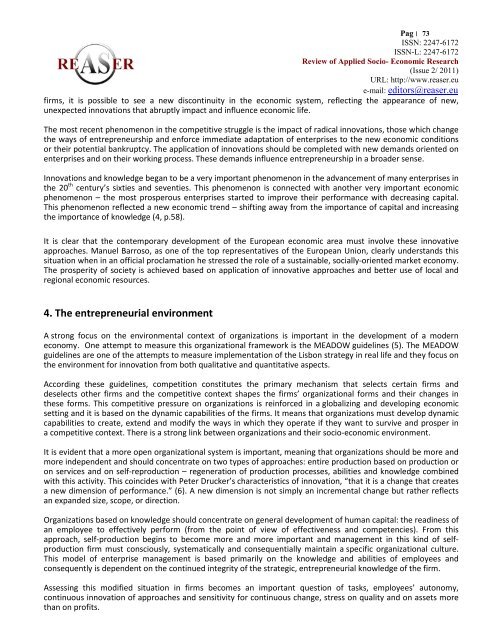Volume 2, ISSUE2/2011 - Review of Applied Socio-Economic ...
Volume 2, ISSUE2/2011 - Review of Applied Socio-Economic ...
Volume 2, ISSUE2/2011 - Review of Applied Socio-Economic ...
Create successful ePaper yourself
Turn your PDF publications into a flip-book with our unique Google optimized e-Paper software.
Pag׀ 73 ISSN: 2247-6172ISSN-L: 2247-6172<strong>Review</strong> <strong>of</strong> <strong>Applied</strong> <strong>Socio</strong>- <strong>Economic</strong> Research(Issue 2/ <strong>2011</strong>)URL: http://www.reaser.eue-mail: editors@reaser.eufirms, it is possible to see a new discontinuity in the economic system, reflecting the appearance <strong>of</strong> new,unexpected innovations that abruptly impact and influence economic life.The most recent phenomenon in the competitive struggle is the impact <strong>of</strong> radical innovations, those which changethe ways <strong>of</strong> entrepreneurship and enforce immediate adaptation <strong>of</strong> enterprises to the new economic conditionsor their potential bankruptcy. The application <strong>of</strong> innovations should be completed with new demands oriented onenterprises and on their working process. These demands influence entrepreneurship in a broader sense.Innovations and knowledge began to be a very important phenomenon in the advancement <strong>of</strong> many enterprises inthe 20 th century’s sixties and seventies. This phenomenon is connected with another very important economicphenomenon – the most prosperous enterprises started to improve their performance with decreasing capital.This phenomenon reflected a new economic trend – shifting away from the importance <strong>of</strong> capital and increasingthe importance <strong>of</strong> knowledge (4, p.58).It is clear that the contemporary development <strong>of</strong> the European economic area must involve these innovativeapproaches. Manuel Barroso, as one <strong>of</strong> the top representatives <strong>of</strong> the European Union, clearly understands thissituation when in an <strong>of</strong>ficial proclamation he stressed the role <strong>of</strong> a sustainable, socially-oriented market economy.The prosperity <strong>of</strong> society is achieved based on application <strong>of</strong> innovative approaches and better use <strong>of</strong> local andregional economic resources.4. The entrepreneurial environmentA strong focus on the environmental context <strong>of</strong> organizations is important in the development <strong>of</strong> a moderneconomy. One attempt to measure this organizational framework is the MEADOW guidelines (5). The MEADOWguidelines are one <strong>of</strong> the attempts to measure implementation <strong>of</strong> the Lisbon strategy in real life and they focus onthe environment for innovation from both qualitative and quantitative aspects.According these guidelines, competition constitutes the primary mechanism that selects certain firms anddeselects other firms and the competitive context shapes the firms’ organizational forms and their changes inthese forms. This competitive pressure on organizations is reinforced in a globalizing and developing economicsetting and it is based on the dynamic capabilities <strong>of</strong> the firms. It means that organizations must develop dynamiccapabilities to create, extend and modify the ways in which they operate if they want to survive and prosper ina competitive context. There is a strong link between organizations and their socio-economic environment.It is evident that a more open organizational system is important, meaning that organizations should be more andmore independent and should concentrate on two types <strong>of</strong> approaches: entire production based on production oron services and on self-reproduction – regeneration <strong>of</strong> production processes, abilities and knowledge combinedwith this activity. This coincides with Peter Drucker’s characteristics <strong>of</strong> innovation, “that it is a change that createsa new dimension <strong>of</strong> performance.” (6). A new dimension is not simply an incremental change but rather reflectsan expanded size, scope, or direction.Organizations based on knowledge should concentrate on general development <strong>of</strong> human capital: the readiness <strong>of</strong>an employee to effectively perform (from the point <strong>of</strong> view <strong>of</strong> effectiveness and competencies). From thisapproach, self-production begins to become more and more important and management in this kind <strong>of</strong> selfproductionfirm must consciously, systematically and consequentially maintain a specific organizational culture.This model <strong>of</strong> enterprise management is based primarily on the knowledge and abilities <strong>of</strong> employees andconsequently is dependent on the continued integrity <strong>of</strong> the strategic, entrepreneurial knowledge <strong>of</strong> the firm.Assessing this modified situation in firms becomes an important question <strong>of</strong> tasks, employees’ autonomy,continuous innovation <strong>of</strong> approaches and sensitivity for continuous change, stress on quality and on assets morethan on pr<strong>of</strong>its.








